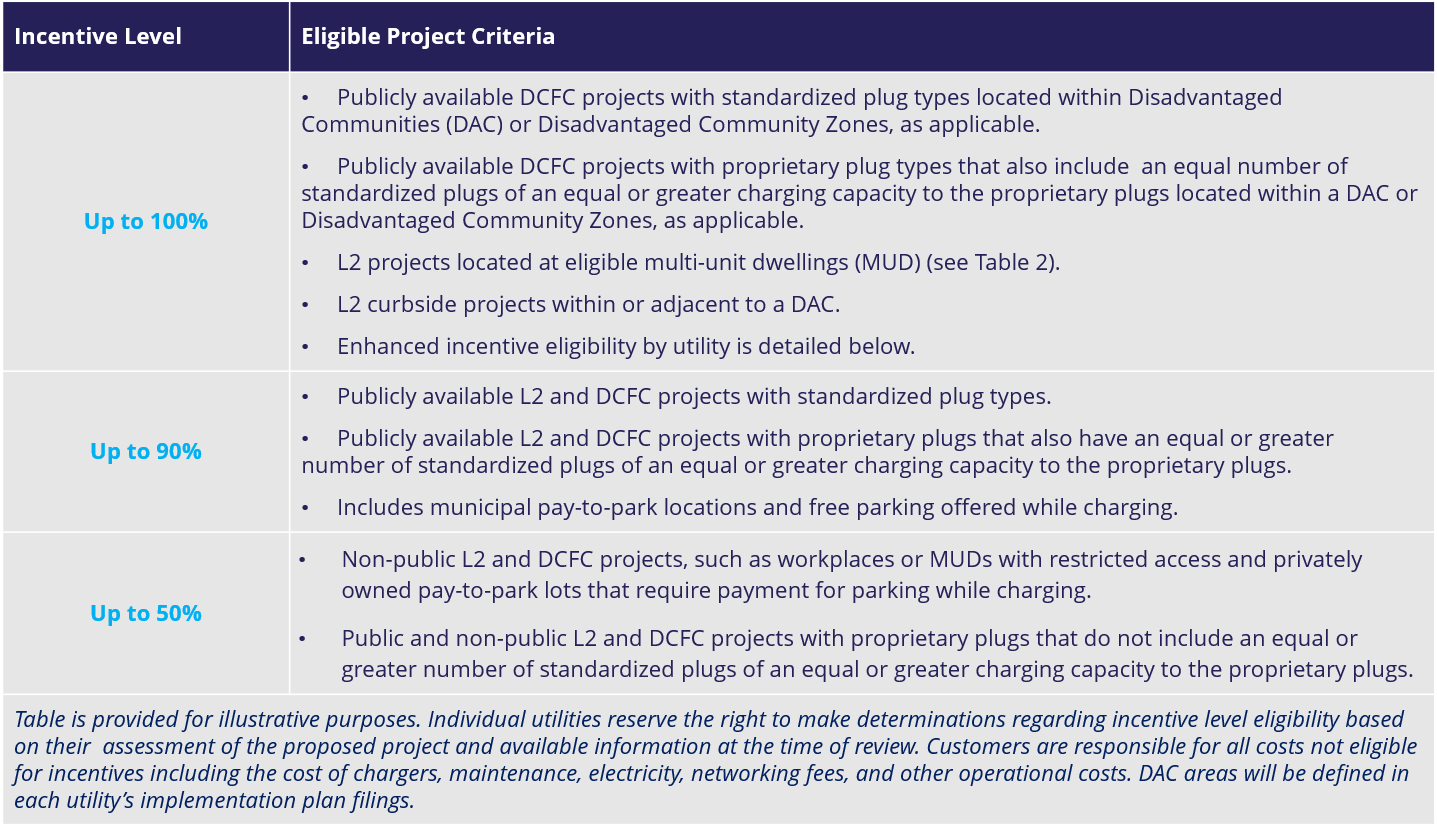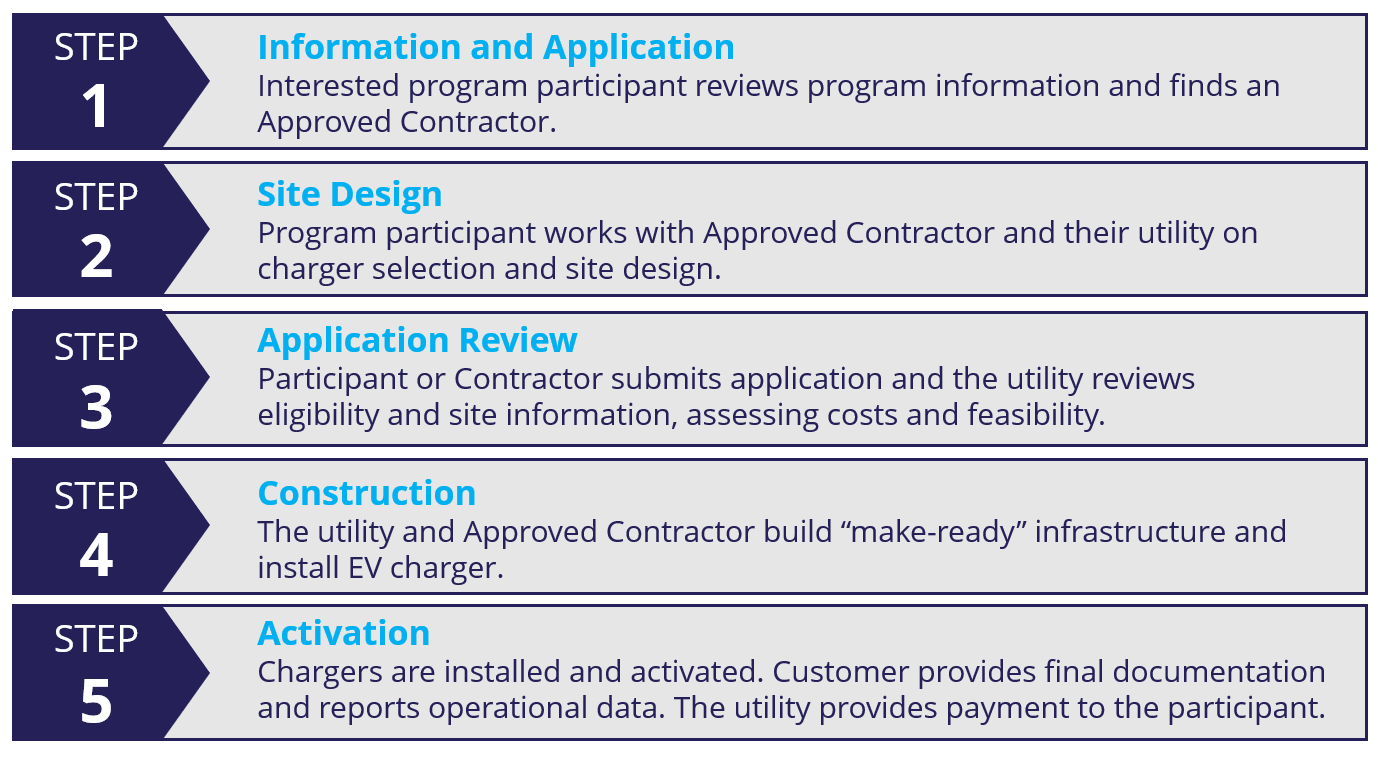Program Overview
The goal of the Electric Vehicle ("EV") Make-Ready Program ("EV Make-Ready Program") is to support the development of electric infrastructure and equipment necessary to accommodate an increased deployment of EVs within New York State by reducing the upfront costs of building charging stations for EVs. Through this EV Make-Ready Program, entities seeking to install or participate in the installation of Level 2 ("L2") and/or Direct Current Fast Charging ("DCFC") chargers can earn incentives that will offset a large portion of, or in some cases, all of the infrastructure costs associated with preparing a site for EV charger installation.
The New York Public Service Commission's November 16th, 2023 Order Approving Midpoint Review Whitepaper's Recommendations with Modifications and September 20, 2024 Order Approving Modifications to the Make-Ready Program mandated several important program updates. All information on this webpage has been updated to reflect up-to-date information about the current program requirements. The updated Participant Guide for the program can be found here.
Program at a Glance
- Supports CLCPA goals as well as New York State’s zero-emission vehicle (ZEV) goal of deploying 850,000 electric vehicles across the state by 2025.
- Total program budget is $1.243 billion, with more than $885 million allocated to support Make-Ready Programs by the New York Joint Utilities.
- $372.5 million must directly benefit Disadvantaged Communities. Disadvantaged Communities are defined as communities that bear burdens of negative public health effects, environmental pollution, impacts of climate change, and possess certain socioeconomic criteria, or comprise high concentrations of low- and moderate-income households. More information about Disadvantaged Communities in New York can be found on NYSERDA's website.
What's Included
Take advantage of the make-ready incentives available through your utility to help install EV charging.

Light-Duty EV Make-Ready Program
Available Incentives
You may be eligible for up to 100% of the electric infrastructure costs associated with new non-residential EV charging stations. Participating in the Make-Ready Program will also reduce your organization's time investment by providing a dedicated point of contact and streamlined, step-by-step experience installing your electric vehicle charging stations.


How to Participate
Your utility is here to help you make the switch to electric by helping bring down the cost of installing EV charging stations. Here’s how it works:

Eligible Equipment
Requirements
Depending on the date a project enters a program agreement with a utility (Commitment Date), chargers installed through the Make-Ready Program must comply with the following technical standards:
- DCFC
- Chargers committed on or after December 16, 2023 must use hardware conformant with ISO 15118-3 and capable of enabling ISO 15118-2 or -20. Once installed, they must be able to run software conformant to ISO 15118-2 or -20 standards by November 16, 2024.
- Chargers committed on or after November 16, 2024 must meet the requirements specified in the bulleted point above and run software conformant to ISO 15118-2 or -20 standards once installed.
- Chargers committed on or after November 16, 2024 must also use hardware conformant with OCPP 2.0.1 or later.
- All L2 projects committed on or after June 1, 2025 must use:
- Chargers that are hardware conformant with ISO 15118-3 and capable of enabling ISO 15118-2 or -20.
- Chargers that are software conformant with ISO 15118-2 or -20.
- Chargers that are hardware conformant with OCPP 2.0.1 or later.
See the table below for a breakdown of the requirements by Commitment Date.
L2 | DCFC | ||||
|---|---|---|---|---|---|
Committed before June 1, 2025 | Committed on or after June 1, 2025 | Committed before December 16, 2023 | Committed between December 16, 2023 and November 15, 2024 | Committed on or after November 16, 2024 | |
ISO 15118 hardware conformance | No requirement | ISO 15118-3, capable of enabling ISO 15118-2 or ISO 15118-20 | No requirement | ISO 15118-3, capable of enabling ISO 15118-2 or ISO 15118-20 | ISO 15118-3, capable of enabling ISO 15118-2 or ISO 15118-20 |
ISO 15118 software conformance | No requirement | ISO 15118-2 or ISO 15118-20 | No requirement | ISO 15118-2 or ISO 15118-20 by November 16, 2024 | ISO 15118-2 or ISO 15118-20 |
OCPP hardware conformance | No requirement | OCPP 2.0.1 or later | No requirement | No requirement | OCPP 2.0.1 or later |
Additionally, effective June 26, 2023, all EVSE sold in New York must be certified with ENERGY STAR V1.0 (April 2017) or V1.2 energy efficiency standards, per the Advanced Building Codes, Appliance and Equipment Efficiency Standards Act of 2022. Please refer to the New York State Appliance and Equipment Efficiency Standards for more information on the current standards.
Equipment List
Equipment must be listed on the Joint Utilities of NY - EPRI Vetted Product List (VPL) to be eligible for the Make-Ready Program starting on March 1, 2025 for DCFC equipment and June 1, 2025 for L2 equipment. For L2 equipment, there are no requirements before June 1, 2025. The Eligible Equipment List maintained by the JU until March 1, 2025 is no longer available.
For Original Equipment Manufacturers: To apply to add your equipment to the EPRI VPL, visit EPRI Home and click the "Vendor Application" tab.
For White-labeled equipment: Both the white-labeling company and the original manufacturer must submit attestations to EPRI certifying that the white-labeled product is the same as the original, tracked to a specific NRTL listing.
Approved Contractors
All customers must select an Approved Contractor who will partner with them to install the right EV solution on site. Approved Contractors will walk customers through the Program details, application process and project construction.
Electrical contractors interested in installing EV charging stations under the Make-Ready Program may apply to become Approved Contractors through the Joint Utilities website.
Utility Resources
Below you can access each company’s EV Make-Ready Program landing pages where customers can find more information and resources to apply for the MRP. If you have questions or need assistance with the MRP, please email your utility at the correct address below.
Utility | Website | |
|---|---|---|
Central Hudson | ||
Con Edison | ||
National Grid | ||
NYSEG | ||
RG&E | ||
Orange and Rockland |
Plug and Budget Tracker
This table tracks progress toward 2025 plug goals and the amount of incentive funds that have been paid out to date. The data is updated monthly. The data is available for download here.
This data was last updated on November 13, 2025.